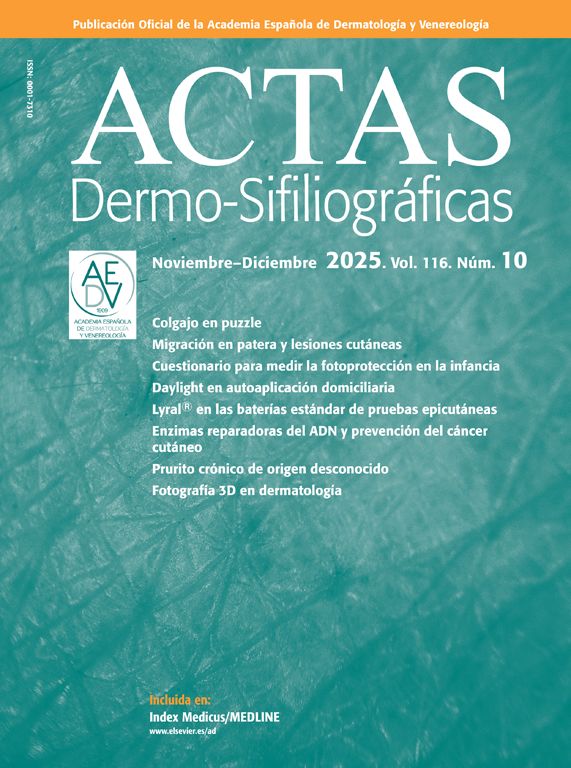A 53-year-old woman with a past medical history of hypertension consulted with a 2-year history of a pruritic lesion on the anterior thigh. Physical examination revealed the presence of a plaque with erythematous and well-demarcated borders of 2cm in its largest diameter. The center exhibited a scaly-crusted area (Fig. 1). No lesions were present in other areas of the body.
Polarized light dermoscopy showed whitish, structureless areas, bright white structures, the presence of follicular keratotic plugs, and erythematous areas at the periphery. Additionally, isolated vessels were observed, some dot-like and others short and linear (Fig. 2).
What is your diagnosis?
DiagnosisDermoscopic diagnosis was consistent with extragenital lichen sclerosus, which was later confirmed histologically (Fig. 3).
CommentaryLichen sclerosus is a chronic inflammatory dermatosis that can affect both the skin and semimucosal surfaces. It is characterized by the presence of atrophic ivory-white papules or plaques that tend to cluster into round, well-demarcated plaques of wrinkled appearance.1 It is more common in women and occurs in 85% of cases in the genital region and 15% in extragenital areas.2 Several authors have considered lichen sclerosus as a subtype of morphea, while others categorize it as a distinct entity due to clinical and histological differences. This remains a matter of discussion, requiring further studies for clarification.3
Dermoscopy is a highly useful diagnostic tool. The most suggestive findings of lichen sclerosus include the presence of yellow-white structureless areas, chrysalis-like structures, and follicular keratotic plugs.4,5
Other, less common dermoscopic findings include a peripheral erythematous halo, scales, bright white structures, erosions, gray dots, telangiectasias, and irregular linear and dotted vessels.2–5
The main differential diagnoses include morphea, necrobiosis lipoidica, Mibelli's porokeratosis, and vitiligo.1
The first-line therapy is high-potency topical corticosteroids. Other options include topical calcineurin inhibitors and phototherapy.5
Conflicts of interestNone declared.






![Hyperkeratosis (blue dotted line), epidermal atrophy (green square), orthokeratotic corneal plug (brown circle), collagen edema and homogenization (brown dotted line), and lymphocytic infiltrate (purple square) (hematoxylin–eosin [H–E], 4×). Hyperkeratosis (blue dotted line), epidermal atrophy (green square), orthokeratotic corneal plug (brown circle), collagen edema and homogenization (brown dotted line), and lymphocytic infiltrate (purple square) (hematoxylin–eosin [H–E], 4×).](https://static.elsevier.es/multimedia/00017310/0000011600000005/v2_202505190855/S0001731025001425/v2_202505190855/en/main.assets/thumbnail/gr3.jpeg?xkr=ue/ImdikoIMrsJoerZ+w9/t1/zx4Q/XH5Tma1a/6fSs=)


